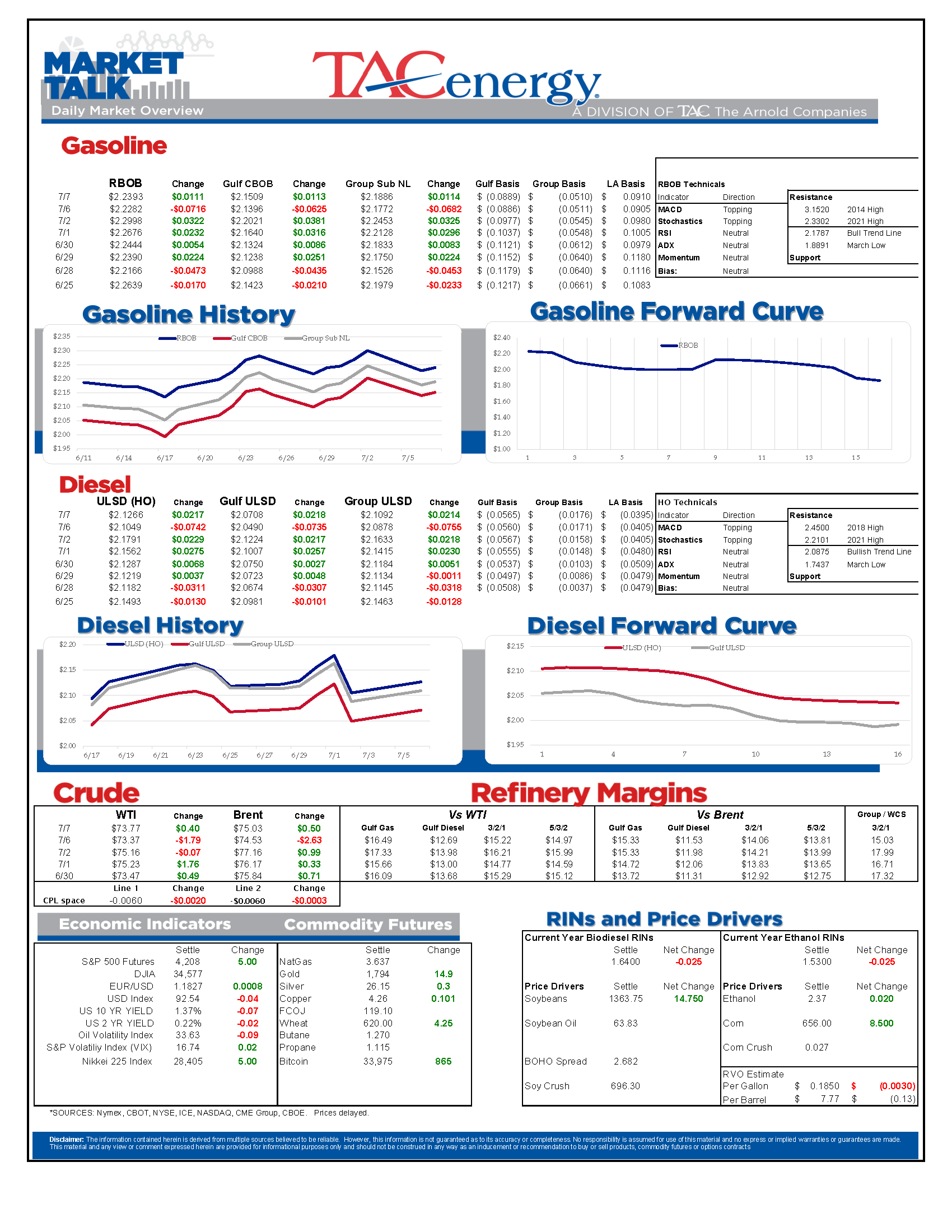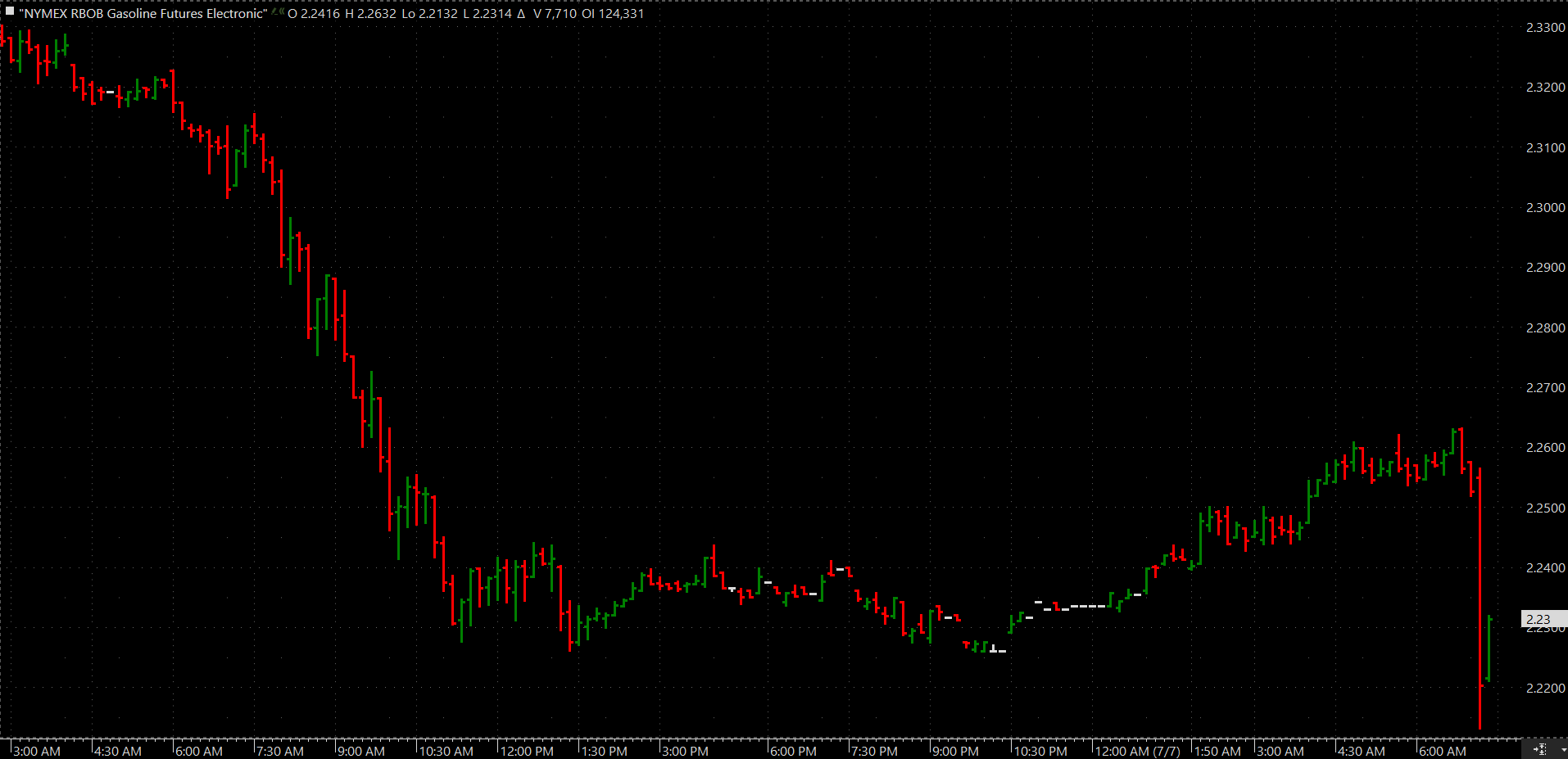Huge Price Reversal From 6-Year Highs

Volatility is back in energy markets after a huge price reversal from 6 year highs in Tuesday’s session was followed up with more whipsaw trading this morning. After Tuesday’s outside down reversal (which the text book will tell you is a bearish signal) we saw prices rally overnight, wiping out more than half of the previous losses, only to see those gains wiped out in 10 minutes of heavy selling this morning before more modest buying picked up again.
The reversals are putting energy prices up to their biggest technical test in 2 months, threatening to finally put an end to the rally that’s been keeping prices moving steadily higher for the past 8 months. Volatile action is often seen when a trend comes to an end, so we could be seeing energy prices finding a top, but they haven’t yet dropped below their trend-lines, so it’s too soon to say that the bull market is over.
Tuesday’s big swings were largely blamed on the OPEC drama, but the sell-off was much more widespread than just petroleum, impacting both equities and numerous other commodities, that suggests fear may be creeping back into the market after an extended period of re-opening fueled optimism seems to have run its course.
While oil prices initially spiked when OPEC failed to come to an agreement, it quickly became clear that a lack of an agreement when the cartel is intentionally withholding production may actually be bearish for prices not bullish. Also, keep in mind that Saudi Arabia made its own production cuts – in excess of what the alliance agreed to – last year, so is free to reverse course and increase output whenever it wants. In both price crashes of 2014 and 2020, we’ve seen the Saudis allow prices to drop to teach the Russians and Iranians (among others) a lesson, and it wouldn’t be surprising to see them do something similar to the UAE now.
A stronger US Dollar also got credit for the selling, as it often does any time commodities see a broad selloff. The problem with that theory is that the correlation between the dollar and energy price movements has been strongly positive lately, which is the opposite of what it’s “supposed” to be. That certainly doesn’t help explain why the dollar moving higher Tuesday was suddenly bearish for oil when the two have been moving higher in tandem for much of the past month.
RINs joined in on the reversal action, following grain and refined products by dropping 10 cents from where they were trading in the early going. Grain prices are seeing an early bounce this morning, as refined products were, which should encourage buyers that may have grown weary after multiple big drops in the past month.
Elsa was briefly upgraded back to Hurricane status, but has since weakened again to a tropical storm and is soon to make landfall on Florida’s northern Gulf Coast. So far no major disruptions to terminal operations have been reported, or are expected, although several facilities shut down temporarily while the storm passes.
Click here to download a PDF of today's TACenergy Market Talk.
News & Views
View All
Energy Futures Are Caught Up In Headline Tug-O-War This Morning
Energy futures are caught up in headline tug-o-war this morning with Canadian oil production concerns and a positive US GDP report trying to push prices higher while sinking Chinese demand worries and Gaza ceasefire hopes are applying downward pressure. The latter two seem to be favored more so far this morning with WTI and Brent crude oil futures down ~45 cents per barrel, while gasoline and diesel prices are down about half a cent and two cents, respectively.
No news is good news? Chicago gasoline prices dropped nearly 30 cents yesterday, despite there not being any update on Exxon’s Joliet refinery after further damage was discovered Wednesday. Its tough to say if traders have realized the supply situation isn’t as bad as originally thought or if this historically volatile market is just being itself (aka ‘Chicago being Chicago’).
The rain isn’t letting up along the Texas Gulf Coast today and is forecasted to carry on through the weekend. While much of the greater Houston area is under flood watch, only two refineries are within the (more serious) flood warning area: Marathon’s Galveston Bay and Valero’s Texas City refineries. However, notification that more work is needed at Phillip’s 66 Borger refinery (up in the panhandle) is the only filing we’ve seen come through the TECQ, so far.
Premiums over the tariff on Colonial’s Line 1 (aka linespace value) returned to zero yesterday, and actually traded in the negatives, after its extended run of positive values atypical of this time of year. Line 1’s counterpart, Line 2, which carries distillates from Houston to Greensboro NC, has traded at a discount so far this year, due to the healthy, if not over-, supply of diesel along the eastern seaboard.
Click here to download a PDF of today's TACenergy Market Talk.

WTI And Brent Crude Oil Futures Are Trading ~$1.50 Per Barrel Lower In Pre-Market Trading
The across-the-board drawdown in national energy stockpiles, as reported by the Department of Energy yesterday, stoked bullish sentiment Wednesday and prompt month gasoline, diesel, and crude oil futures published gains on the day. Those gains are being given back this morning.
The surprise rate cut by the People’s Bank of China is being blamed for the selling we are seeing in energy markets this morning. While the interest rate drop in both short- and medium-term loans won’t likely affect energy prices outright, the concern lies in the overall economic health of the world’s second largest economy and crude oil consumer. Prompt month WTI and Brent crude oil futures are trading ~$1.50 per barrel lower in pre-market trading, gasoline and diesel are following suit, shaving off .0400-.0450 per gallon.
Chicagoland RBOB has maintained its 60-cent premium over New York prices through this morning and shows no sign of coming down any time soon. Quite the opposite in fact: the storm damage, which knocked Exxon Mobil’s Joliet refinery offline on 7/15, seems to be more extensive than initially thought, potentially extending the repair time and pushing back the expected return date.
There are three main refineries that feed the Chicago market, the impact from one of them shutting down abruptly can be seen in the charts derived from aforementioned data published by the DOE. Refinery throughput in PADD 2 dropped 183,000 barrels per day, driving gasoline stockpiles in the area down to a new 5-year seasonal low.
While it seems all is quiet on the Atlantic front (for now), America’s Refineryland is forecasted to receive non-stop rain and thunderstorms for the next four days. While it may not be as dramatic as a hurricane, flooding and power outages can shut down refineries, and cities for that matter, all the same, as we learned from Beryl.





